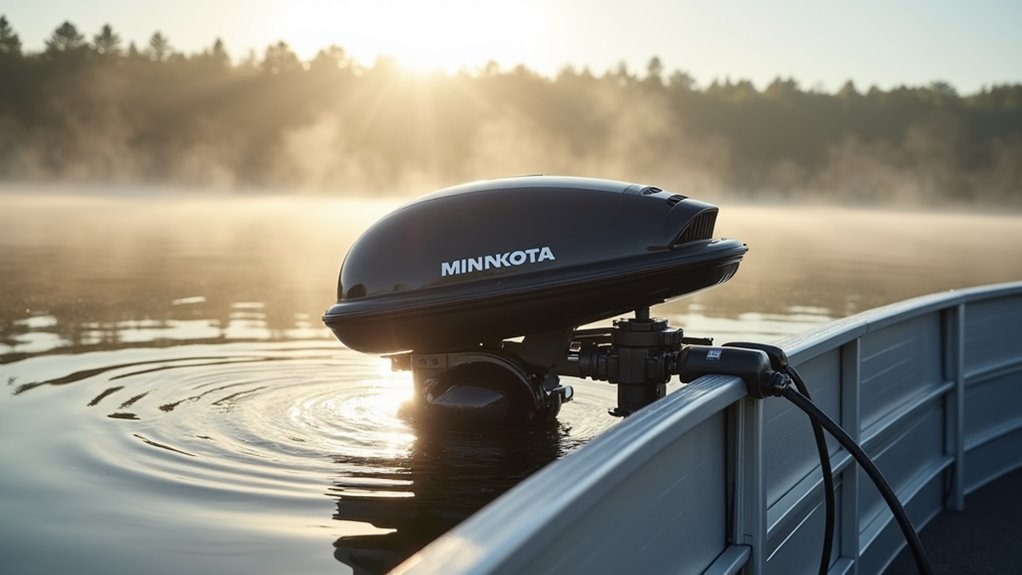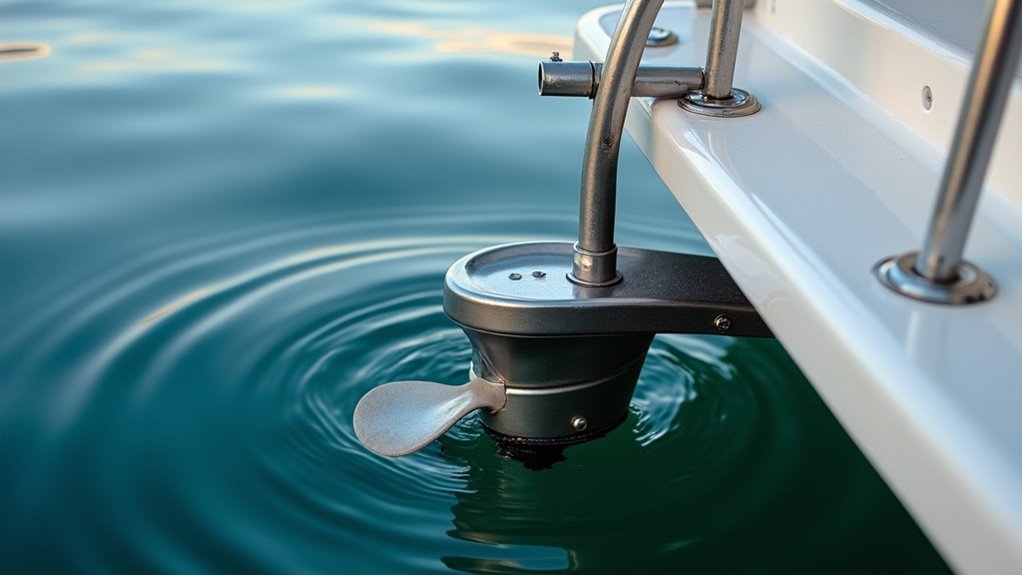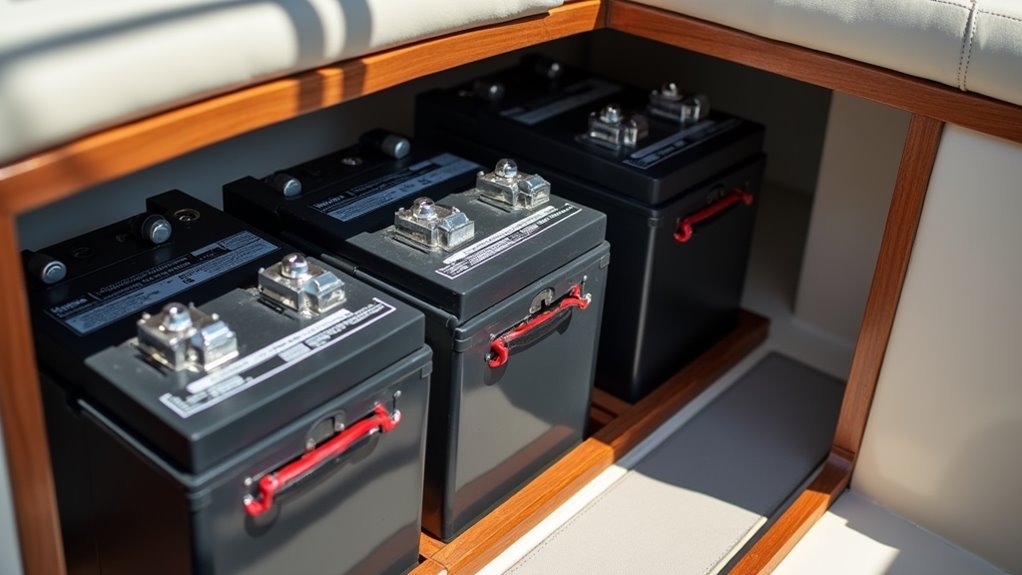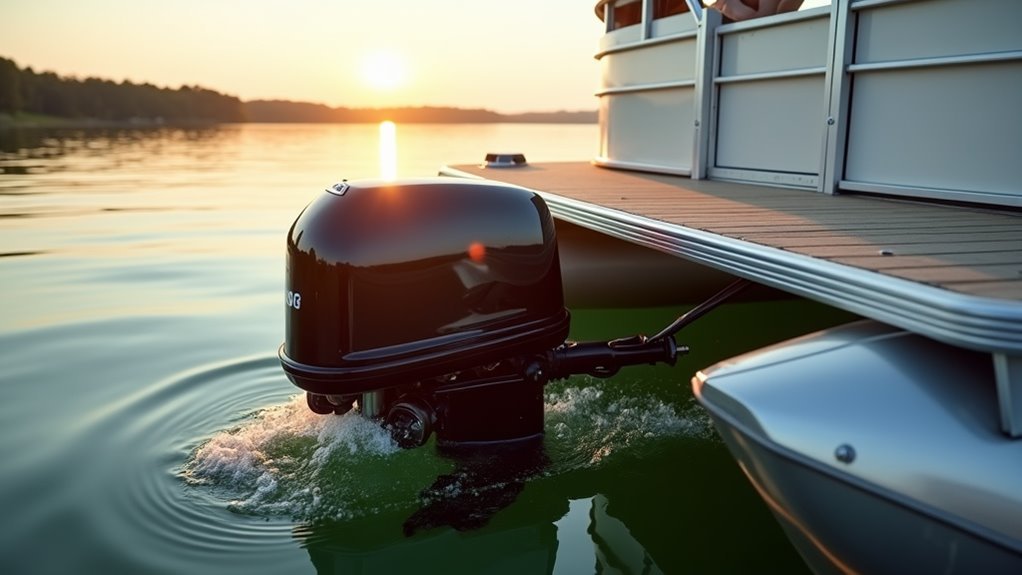We've all been there – trying to figure out the perfect trolling motor size for our pontoon boat while staring at countless options. It's a vital choice that can make or break our time on the water, affecting everything from battery life to maneuverability. Whether you're upgrading your current setup or outfitting a new pontoon, we'll walk you through the top motor sizes that'll keep you gliding smoothly across the lake, matched perfectly to your boat's specific needs.
Understanding Thrust-to-Weight Ratios for Pontoons
Power plays a critical role when choosing a trolling motor for your pontoon boat.
We'll show you how to determine the right thrust-to-weight ratio to keep you gliding smoothly across the water. Here's a simple formula: take your pontoon boat's weight in pounds, divide it by 100, then multiply by 2. That'll give you the minimum thrust you need for good maneuverability.
Not sure about your boat's weight? We recommend checking the NADA boat directory for accurate numbers.
For peak performance, you'll want to aim a bit higher than the minimum – especially if you're dealing with choppy waters or carrying extra passengers. A 3,000-pound pontoon, for instance, needs at least 60 pounds of thrust, but we suggest going for 65-80 pounds to guarantee you've got plenty of power.
Small Pontoon Boats: 40-55 Lb Thrust Options
Many small pontoon boats under 1,500 pounds can cruise comfortably with motors in the 40-55 lb thrust range.
We've found that selecting the right trolling motor for your pontoon comes down to a simple calculation: take your boat's weight in pounds, divide by 100, and multiply by 2. This gives you the ideal thrust power you'll need for peak performance.
For most small pontoon boats, we recommend choosing a thrust trolling motor between 40-50 lbs, depending on your operational environment.
If you're cruising calm lakes, you can lean toward the lower end. But if you're facing choppier waters, you'll want maximum thrust.
Don't forget about the shaft length – we suggest 48-54 inches to guarantee your trolling motor maintains proper water contact in various conditions.
Mid-Size Pontoons: 65-80 Lb Thrust Solutions

When you're operating a mid-size pontoon boat weighing between 2,000 to 3,000 pounds, you'll need to step up to a more robust trolling motor in the 65-80 lb thrust range.
We recommend considering the Minn Kota Terrova with its 80 lb thrust option, perfect for mid-size pontoons. Look for longer shaft lengths around 60 inches to handle choppy waters while maintaining control.
Here's why the right thrust rating matters for your boating freedom:
- You'll glide effortlessly through windy conditions without fighting the current.
- Your battery longevity improves since you're not constantly pushing the motor to its limits.
- You'll experience smoother maneuvering in tight spots and rough waters.
Large Pontoons: 100-112 Lb Thrust Requirements
Large pontoons demand serious muscle when it comes to trolling motor power, which is why we'll need to look at thrust ratings between 100-112 pounds for boats over 3,000 pounds.
While basic calculations suggest 60 pounds might work, we've found that larger boats need extra oomph to handle wind and choppy waters with confidence.
Popular models like the Minn Kota Ulterra and Terrova offer the perfect thrust requirements for ideal performance and maneuverability.
We'll want to pay attention to battery capacity too – these powerful motors typically run on dual 12-volt or 24-volt systems to keep you cruising all day long.
With the right setup, you'll enjoy smooth handling and reliable power, even when conditions get rough.
Don't compromise on thrust – your large pontoon deserves the muscle to move freely.
Shaft Length Selection Based on Deck Height

Beyond choosing the right thrust power, selecting the proper shaft length stands as a key factor in your pontoon boat's performance.
We'll help you measure from your motor mount to the water surface and add 18-22 inches for ideal clearance. A 60-inch shaft length typically works well for most pontoon boats, especially those with higher decks.
- Your deck height directly impacts trolling motor performance – don't settle for a shaft that's too short.
- We've seen too many boaters struggle with short shafts in rough water, leaving their props gasping for water.
- Freedom on the water comes from choosing longer shafts that keep you moving smoothly in any conditions.
Power Requirements for Different Water Conditions
Understanding your pontoon boat's power needs starts with the water conditions you'll face most often.
We'll help you determine the right thrust ratings to keep your adventures smooth and worry-free. For most pontoon boats, we calculate power requirements by taking your boat's weight in pounds, dividing by 100, and multiplying by 2. That means a 3,000-pound boat needs about 60 pounds of thrust.
Rough water conditions demand special attention to both power and shaft length.
We recommend looking for trolling motors with thrust ratings between 55 and 112 pounds, depending on your boat's size. Plus, you'll want an extra 18 to 22 inches of shaft length in choppy waters to maintain proper propeller performance and motor functionality.
This setup helps prevent air exposure, which can harm your motor's efficiency.
Battery Configuration for Various Thrust Levels

With your trolling motor's power needs mapped out, let's look at the battery configurations that'll keep you moving on the water.
For pontoon boats with 55 lbs of thrust, we recommend a 12-volt setup that'll give you reliable performance. Larger boats needing 80-112 lbs of thrust will benefit from a 24-volt configuration, delivering the extra power you need.
- Choose deep-cycle batteries for sustained power that won't leave you stranded
- Match your amp-hour rating to your power demands for worry-free cruising
- Consider Optima Blue Top batteries for maintenance-free freedom on the water
Remember to always select deep-cycle batteries instead of standard starting batteries – they're specifically designed for the consistent power delivery your trolling motor needs for those long days exploring the lake.
Motor Placement Impact on Size Selection
The location of your trolling motor plays an essential role in determining the size you'll need.
When we're selecting a trolling motor for our Pontoon, we've got to take into account whether we're going with a bow mount or rear-mounted setup. For bow mounts, we'll typically need a longer shaft length – up to 60 inches – to guarantee proper water immersion from that higher position. It's all about getting the right clearance; we recommend measuring from the mount to the water and adding 18-22 inches.
While rear-mounted motors can work with shorter shafts due to their lower position, they might limit our control over the boat.
We'll also need to reflect on our boat design and make sure we've got enough space around the motor for smooth operation.
Performance Analysis of Popular Thrust Ratings

Selecting an appropriately sized trolling motor comes down to understanding thrust ratings and how they'll perform on your pontoon boat.
We've found that matching thrust to boat weight is essential – you'll need about 2 lbs of thrust for every 100 lbs of boat weight for peak performance on the water.
For the best experience on your pontoon boat adventures, consider these key performance factors:
- A 3,000-pound pontoon needs at least 60 lbs of thrust to move freely through the water.
- Motor performance improves dramatically with 80+ lbs of thrust in windy conditions.
- Higher thrust ratings guarantee better maneuverability when tackling larger bodies of water.
Remember that water conditions play a major role in how your trolling motor performs, so we always recommend going with more thrust than you think you'll need.
Seasonal Considerations for Motor Size Choice
Seasonal changes greatly impact which trolling motor size you'll need for your pontoon boat throughout the year.
We've found that warmer months call for longer trolling motor shafts around 60 inches to handle those choppy summer waters. During fall's calmer conditions, we can get by with a 54-inch shaft that's easier to manage.
When we're dealing with seasonal weather patterns, especially spring and fall winds, we'll want a high-thrust trolling motor with about 80 pounds of thrust to maintain control.
For shifting water conditions, an adjustable trolling motor shaft gives us the flexibility we need, particularly in shallow spring waters.
If we're braving the cold for winter fishing, we'll need longer trolling motor shafts designed for consistent operation in icy conditions.
Frequently Asked Questions
How Big of a Boat Will a 55LB Trolling Motor Push?
Like a trusty pack mule, our 55lb trolling motor's weight capacity confidently pushes boats up to 2,200 lbs in calm waters, but we'd recommend less weight for ideal power requirements in challenging fishing conditions.
What Size Motor Should a Pontoon Boat Have?
We'll calculate your pontoon's motor size based on total weight – typically you'll need 2 pounds of thrust per 100 pounds of boat. For a 3,000-pound pontoon, aim for 60-80 pounds of thrust.
How Big of a Motor Do You Need on a Pontoon to Pull a Tube?
We'll need at least 75-90 pounds of thrust for safe tubing, considering your pontoon's weight capacity and water conditions. Higher power guarantees smooth towing, while maintaining stability for an awesome ride.
Where Is the Best Place to Put a Trolling Motor on a Pontoon Boat?
While we'd love to tell you there's one perfect spot, we've found bow mounting offers superior steering dynamics and stability, though rear placement works if you're mindful of water current effects.